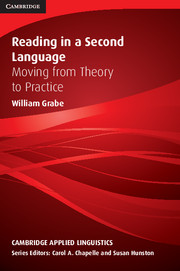Book contents
- Frontmatter
- Contents
- Series editors' preface
- Preface
- I FOUNDATIONS OF READING
- II PATTERNS OF VARIATION IN READING
- III DEVELOPING READING COMPREHENSION ABILITIES
- Chapter 10 Building main-idea comprehension
- Chapter 11 Becoming a strategic reader
- Chapter 12 Building awareness of discourse structure
- Chapter 13 Vocabulary and reading comprehension
- IV EXPANDING READING COMPREHENSION SKILLS
- References
- Author Index
- Subject Index
Chapter 12 - Building awareness of discourse structure
from III - DEVELOPING READING COMPREHENSION ABILITIES
Published online by Cambridge University Press: 05 August 2012
- Frontmatter
- Contents
- Series editors' preface
- Preface
- I FOUNDATIONS OF READING
- II PATTERNS OF VARIATION IN READING
- III DEVELOPING READING COMPREHENSION ABILITIES
- Chapter 10 Building main-idea comprehension
- Chapter 11 Becoming a strategic reader
- Chapter 12 Building awareness of discourse structure
- Chapter 13 Vocabulary and reading comprehension
- IV EXPANDING READING COMPREHENSION SKILLS
- References
- Author Index
- Subject Index
Summary
In general, we have found incredibly positive support for just about any approach to text structure instruction for expository prose. It appears that any sort of systematic attention to clues that reveal how the authors attempt to relate ideas to one another or any sort of systematic attempt to impose structure on a text, especially in some sort of visual re-representation of the relationship among key ideas, facilitates comprehension as well as both short-term and long-term memory for the text.
(Pearson & Fielding, 1991: 832)It is well established that reading comprehension depends on a reader's awareness of how discourse is structured. Good readers are tuned to the ways that information is organized and to the signaling mechanisms that provide the cues to this organization. Good readers are able to identify the main or topic sentences as they appear in a text and are sensitive to text structures that help identify when and where to find main-idea sentences. Good readers recognize when new topics are introduced, how they are maintained through pronouns and other anaphoric cues, and when there is a topic shift, or when new themes or concepts are introduced. They are able to recognize the vocabulary that signals maintenance or shifts in discourse information as well as lexical forms that commonly identify specific organizational patterns in texts (e.g., cause–effect, comparison–contrast, problem–solution).
Discourse-structure awareness is often associated with a reading strategy or set of strategies (e.g., recognizing main ideas, inferring connections among parts of a text, recognizing organizational patterns in texts, identifying typical genre features of a text).
- Type
- Chapter
- Information
- Reading in a Second LanguageMoving from Theory to Practice, pp. 243 - 264Publisher: Cambridge University PressPrint publication year: 2008



